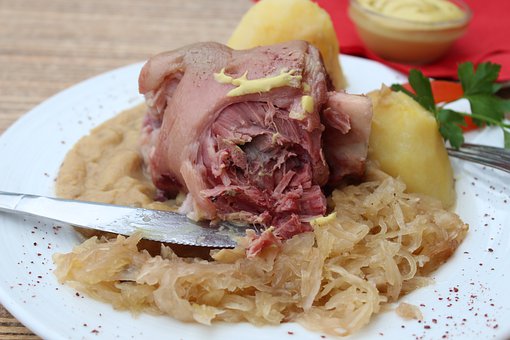You can make your own healthy and delicious sauerkraut at home easily and economically by following this recipe. Using a jar rather than a crock lets you see the cabbage transform into kraut.
Making your own sauerkraut is easy! Follow this step-by-step tutorial to learn how.
You can now make one of our favorite probiotic-rich foods at home easily with our simple and clear directions.
Learn to make healthy, delicious and probiotic-rich Sauerkraut at home for less!
If you are reading this, it is likely that you are already aware of the health benefits of eating fermented foods.
The following text is a deeper exploration of what lacto-fermentation is and how it benefits those who consume foods like sauerkraut.
Not only is sauerkraut healthy for your gut, but it’s also delicious. Its tangy-tart flavor pairs well with grilled burgers, hot dogs, brats, sandwiches, salads, and more.
Eating a small amount of food before a meal will increase the amount of saliva produced, lower the pH level in the stomach, and cause certain digestive enzymes to become active which will help to digest the food more efficiently.
Making your own sauerkraut at home is healthy and economical. A jar of sauerkraut at the store or farmers market would cost you $7-10, but you can make it at home for $4 or less.
Why we love this method for making homemade Sauerkraut!
The sauerkraut-making method we use is simple and produces a small jar of kraut that ferments in 7-14 days, depending on the temperature of your home.
The temperature of your surroundings will affect how quickly your sauerkraut ferments. If it is warmer, it will go faster, and if it is cooler, it will take longer. Another plus of making sauerkraut in a quart jar is that smaller amounts will ferment more quickly than larger ones.
Use Aloe Digest for better nutrient absorption and healthy digestion!
What you’ll need to make Sauerkraut.
Sauerkraut only requires two ingredients, cabbage and salt. But to turn cabbage into kraut, you need just a handful of common kitchen items:
- Fresh cabbage – Look for cabbage that is firm and heavy for it’s size, but not too large. The leaves should be crisp, slightly shiny, and blemish-free.
- Sea salt – It’s important to use sea salt and not iodized salt when making sauerkraut. We use fine sea salt for this recipe.
- 1-quart wide mouth glass jar – This will serve as your fermentation ‘vessel’ instead of a stoneware crock. Using a jar allows you to see what’s happening throughout the process and they’re easy to source.
- Large knife – You’ll need a large, sharp knife such as a chef’s or cook’s knife to remove the core of the cabbage and to thinly slice it.
- Cutting Board
- Large Mixing Bowl – Any kind will work, just be sure it’s large enough to be able to hold all of the cabbage once it’s sliced.
- Small zip-top plastic freezer bag – You’ll fill this bag with tap water to create an inexpensive weight that helps keep the cabbage under the brine (more about that later!) A sandwich-size bag works best and be sure to use a ‘freezer’ bag since these are thicker and usually have a double seal or zipper so they are less likely to leak.
- Lid – A screw-on plastic or metal 2-piece band + lid is all you need.
- Airlock, optional – An airlock is a special lid or lid attachment that allows gases created by fermentation to escape on their own. This eliminates the need to manually release the gases or ‘burp’ the jars. Our favorite pickle pipes are those that are a one-piece design that makes them easy to use.
- Weight, optional – If you prefer not to use a water-filled plastic bag as a weight and you think you’ll want to continue your fermentation journey then you may want to invest in a set of glass or ceramic fermentation weights.
Fancy isn’t always better!
You don’t need any fancy equipment to ferment foods.
We have made sauerkraut in jars, crocks, with lids, and without lids. We have also used airlocks and weights, or just a plastic freezer bag filled with water.
The point is that you don’t need special equipment to be successful, you just need to start.
As you become more adventurous in your fermentation explorations, you can add some fancy crocks, weights, and airlocks to your repertoire.
We’re going to keep it simple and explain how to make sauerkraut so that anyone can feel confident making their first batch today.
Making Sauerkraut: Step by Step
Step 1: Weighing and Shredding the Cabbage
You will need one pound of salt for every five pounds of cabbage. Begin with firm, tight heads of green cabbage. Find the weight of the cabbage, then divide it by five to calculate how much salt is needed.
In order to get 2% salt by weight, you need 20 grams of salt for every kilogram of cabbage. This would be the equivalent of roughly one tablespoon of kosher salt per pound of cabbage.
Remove the outermost leaves from the cabbage.
Shred the cabbage by hand or using a mandoline or food processor.
Step 2: Add Salt, Spices, Knead, and Squeeze
Add the shredded cabbage to the ceramic fermentation crock, sprinkling the salt on it intermittently as you fill it up.
Begin by placing the cabbage in a large mixing bowl if you are using a glass Mason jar. Next, sprinkle the salt over the cabbage and mix it well.
After chopping the cabbage, squeeze and knead it for a few minutes to begin drawing out its liquid. Let it stand in between and cover it to prevent the brine from evaporating.
After 15 minutes have passed, come back and squeeze and knead the cabbage again to help release more brine.
The amount of brine you get and how long it will take will depend on the cabbage, but you should have a decent amount after one to four hours.
For a more German-style kraut, mix in caraway seeds. For a more Alsatian style, mix in juniper.
Transfer the cabbage and its brine to a Mason jar.
You shouldn’t fill the jars or crock more than two-thirds because the contents might overflow when it starts to ferment.
Step 3: Weigh It Down
Compress the cabbage by pushing down on it, which should make the brine rise up. Ideally, the brine should cover the cabbage by about an inch.
If you did not save the outer cabbage leaves, you will need to make some extra brine. If you did save the outer cabbage leaves, lay them across the top of the shredded cabbage and use the weights on top of that to keep little shreds from sneaking up above the weights.
Make sure all the cabbage, including the leaves, is fully submerged in the brine.
Step 4: Add Extra Brine, if necessary
If the cabbage is not submerged in brine, more brine must be added so that the level is above the cabbage. The new brine should have the same salinity (2%) as the cabbage and its brine.
Measure the amount of water you need to fill your vessel. For every 100 grams of water, add two grams of salt. This will create a saltwater brine. Add the brine to your vessel until the cabbage is well covered.
Some people say that fluoridated water can’t be used for fermentation, but I’ve never had a problem with it.
I have not found fluoride in tap water to be a major hindrance to fermentation.
Step 5: Seal and Store in a Cool, Dark Place
To preserve your ferment, make sure to seal your ferment and keep it in a cool, dark place. The temperature plays a role in fermentation by promoting the growth of some types of bacteria while inhibiting others.
This means that you can keep your sauerkraut between 65 and 70 degrees Fahrenheit, or 18 to 21 degrees Celsius.
Storing your food in clear glass containers in the shade or dark is best to prevent the light from degrading the food.
Step 6: Wait, then Eat
You need to wait a day or two for the kraut to start bubbling and fizzing. This happens when the lactobacillus becomes the dominant microbe and starts to eat through the sugars.
If your vessel is pretty full, you may want to set it on a rimmed tray, just in case it does bubble over. This is when it will become clear that you have something alive on your hands—a little microbial universe.
After a week or two, when the fermentation has calmed down, you can open the crock and try a taste.
Even though it may be tempting to open and close the sealed container often, it is not recommended as it increases the chances of molds and other bacteria forming. Wash your hands and utensils before sticking them in the container to prevent this.
As the person responsible for making sure the kraut stays healthy, you should carefully remove any mold that appears on the surface.
If the cabbage rises to the top of the mixture, push it back down. If the mixture ever seems too low, just make more following the same 2% salinity formula, and top it up.
After approximately three weeks, your sauerkraut will be fairly developed, and will taste quite sour. You can allow it to ferment for another few weeks, up to around six weeks in total.
Once the cabbage reaches the desired level of fermentation, it is best to move it to the fridge. The colder temperature and high acidity will prevent any further fermentation.
How to Know when your Sauerkraut is Ready to Eat
Your sauerkraut is ready to eat when it tastes good to you. The flavor should be tart, tangy, and mildly salty.
If you want your sauerkraut to be more sour, let it ferment for a longer period of time. Check on it daily to make sure it doesn’t become too fermented or develop mold.
Use these 3 cues to help you determine when it’s ready to enjoy:
- Flavor: It should have a tart and tangy flavor that’s similar to pickles but without the garlic and dill. While it should be tart, it should not be overly acidic like vinegar.
- Color: The color of the cabbage is more yellow than it is green. It should look slightly translucent, as if it’s been cooked.
- Texture: The cabbage is softer than when it initially went into the jar but still retains a bit of crunch.
READ MORE: Digestion: Healthy Habits









